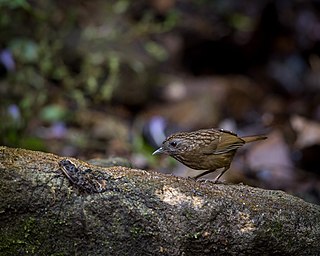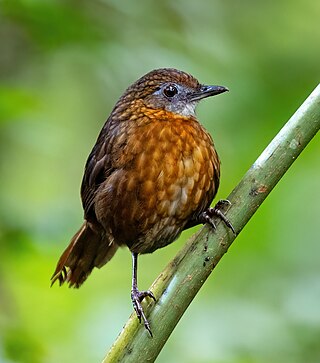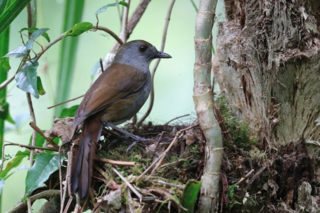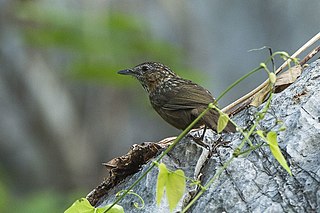
The pin-striped tit-babbler, also known as the yellow-breasted babbler, is a species of bird in the Old World babbler family Timaliidae that is found in South and Southeast Asia.

The malia is a medium-sized babbler-like passerine. It has an olive-green plumage, yellowish head and chest, and pinkish-brown bill. The young is duller than the adult. It is the only member of the genus Malia.

The melampittas are a family, Melampittidae, of New Guinean birds containing two enigmatic species. The two species are found in two genera, the greater melampitta in the genus Megalampitta and the lesser melampitta in the genus Melampitta. They are little studied and before being established as a family in 2014 their taxonomic relationships with other birds were uncertain, being considered at one time related variously to the pittas, Old World babblers and birds-of-paradise.

The streaked wren-babbler is a species of bird in the family Pellorneidae. It is found in Bangladesh, Cambodia, China, India, Laos, Malaysia, Myanmar, Thailand and Vietnam. Its natural habitats are subtropical or tropical moist lowland forest and subtropical or tropical moist montane forest.

The mountain wren-babbler is a species of bird in the family Pellorneidae. It is native to the Iran Mountains of northeastern Borneo. Its natural habitats are subtropical or tropical moist lowland forest and subtropical or tropical moist montane forest.

The rusty-breasted wren-babbler is a species of bird in the family Pellorneidae. It is endemic to western Sumatra in Indonesia.

The long-billed wren-babbler is a species of bird in the family Pellorneidae.

The Sikkim wedge-billed babbler or blackish-breasted babbler is a species of bird in the Old World babbler family (Timaliidae). It is named for the Indian state of Sikkim.

The golden babbler is a babbler species in the family Timaliidae. It occurs from the foothills of the Eastern Himalayas to Southeast Asia and inhabits subtropical lowland and montane forests. It is listed as Least Concern on the IUCN Red List because of its wide distribution.

The chestnut-winged babbler is a babbler species in the family Timaliidae. It occurs in the Malay Peninsula from southern Thailand to Singapore, and in Sumatra. It inhabits forests and shrublands up to an elevation of 800 m (2,600 ft). It is listed as Least Concern on the IUCN Red List.

The black-chinned babbler is a babbler species in the family Timaliidae. It occurs in the foothills of the Himalayas from the Murree Hills in Pakistan to eastern Nepal. It inhabits subtropical and temperate forest at 245–2,750 m (804–9,022 ft) altitudes. It is terrestrial. It is listed as Least Concern on the IUCN Red List.

The rufous-capped babbler is a babbler species in the family Timaliidae. It occurs from the Eastern Himalayas to northern Thailand, Laos, eastern China to Vietnam and Taiwan. It inhabits temperate forest with dense bushes or bamboo and is listed as Least Concern on the IUCN Red List.

The rufous-fronted babbler is a babbler species in the Old World babbler family. It occurs from the Eastern Himalayan foothills to Southeast Asia at altitudes of 120–2,100 m (390–6,890 ft).
The Malayan swamp babbler, previously named the white-chested babbler, is a species of bird in the ground babbler family, Pellorneidae, that is found in the Malay Peninsula, Sumatra, the Riau Islands, the Lingga Islands and the island of Belitung. It was formerly considered to be conspecific with the Bornean swamp babbler.

The Bagobo babbler or Bagobo robin is a monotypic species of bird with its taxonomy undergoing numerous changes and is currently classified as Muscicapidae or an old world flycatcher. It is endemic to the Philippines only found in Mindanao.

The Bicol ground warbler is a species of passerine bird in the family Locustellidae. It is endemic to the island of Luzon in the Philippines, where it is found in the southern parts of the island. Along with its other conspecifics, such as the Cordillera ground warbler and the Sierra Madre ground warbler, it is one of the most elusive birds in the country. Its natural habitat is tropical moist lowland forest. It is threatened by habitat loss.

The jungle babblers are a family, Pellorneidae, of mostly Old World passerine birds belonging to the superfamily Sylvioidea. They are quite diverse in size and coloration, and usually characterised by soft, fluffy plumage and a tail on average the length of their body, or longer. These birds are found in tropical zones, with the greatest biodiversity in Southeast Asia and the Indian subcontinent.

Gypsophila is a genus of birds in the family Pellorneidae.

The Annam limestone babbler, also known as the khướu đá hoa in Vietnamese, is a species of bird in the family Pellorneidae. It is native to the limestone hills of northern Indochina. It was formerly considered a subspecies of the variable limestone babbler but a 2020 study recovered it as a distinct species.

The rufous limestone babbler is a species of bird in the family Pellorneidae. It is endemic to the limestone hills of central Thailand. It was formerly considered a subspecies of the variable limestone babbler but a 2020 study recovered it as a distinct species.




















